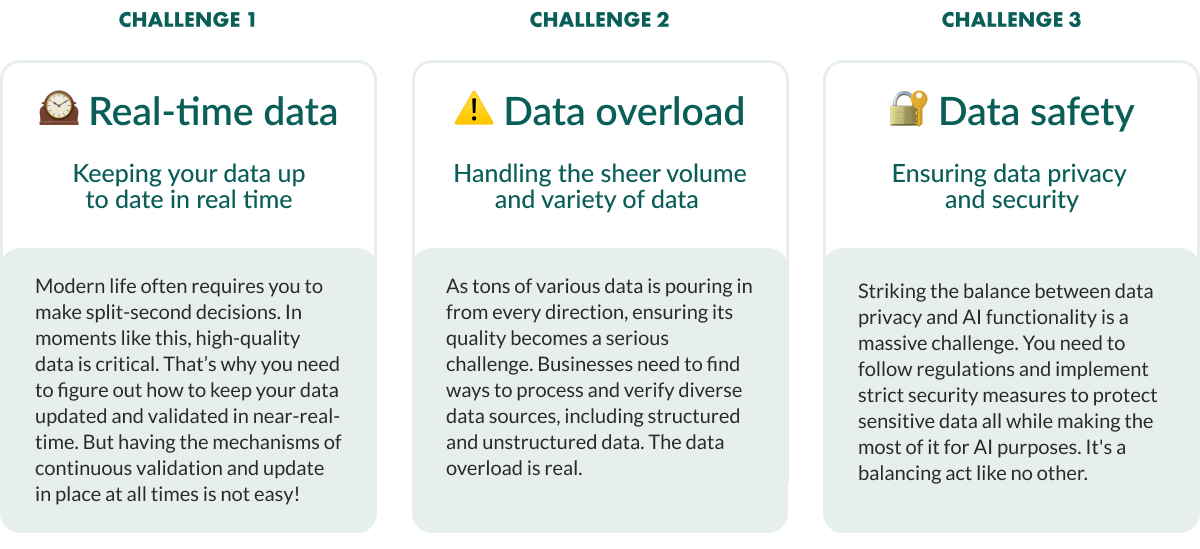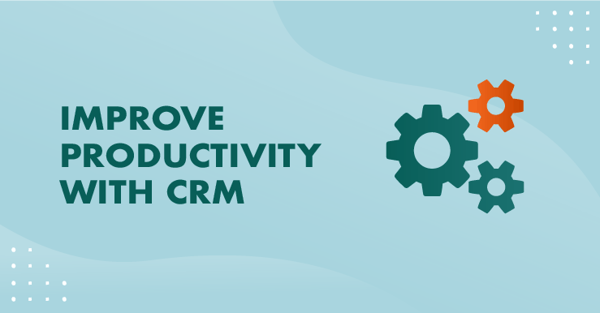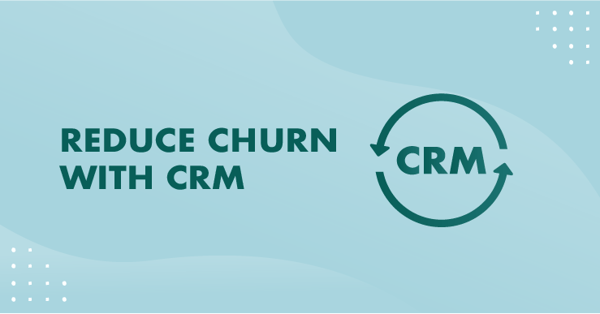Artificial Intelligence (AI) is all the rage these days.
The integration of AI into business operations has (literally) changed the world forever.
However, there's a crucial element that determines the success or failure of AI initiatives.
And it’s not taking puny humans out of the picture, as you might have thought. 😆 It’s high-quality data!
Simply put – it’s the data that makes AI work like magic.
Whether it's streamlining operations, enhancing customer experiences, or making strategic decisions, the AI strategy is directly linked to the data strategy.
In this article we will take a closer look at the vital role of data quality in AI implementation and why it is the bedrock for sustainable business growth. We will also discuss the reasons behind poor data, explore key data quality challenges, and provide strategies to improve data quality and create a comprehensive data strategy.
But, first, let’s address the elephant in the room – why feeding AI low quality data is a recipe for disaster.
The "Garbage In, Garbage Out" principle
If you want to make a tasty dish – you need fresh, good quality ingredients.
If you put spoiled or bad ingredients in it, the dish won’t taste good, no matter how hard you try. And if you don’t add all the necessary ingredients – the dish will not come out right at all.

That’s the essence of the “Garbage In, Garbage Out” (GIGO) principle. The same is true in the world of computers and AI.
When we use AI in a software program, it needs good quality data to work well. If the data going into the AI system is messy, wrong, or incomplete, then the AI won't be able to give good results.
🤔 Why? Because AI doesn’t have the magical powers to fix bad data!
So, if the data going in is garbage, the results coming out, such as answers or predictions, will also be garbage.
That’s why having good quality data is super important for AI to work its magic and give accurate, helpful answers or predictions. Quality data acts as the fuel that powers AI algorithms, allowing them to generate accurate insights and deliver value.
Unfortunately, a staggering 87% of organizations nowadays have low confidence in their data quality.
Why quality data is AI’s superpower
High-quality data is the foundation upon which AI algorithms are built. It’s the real superpower that allows AI to do its magic.
Without accurate, reliable and complete datasets, AI systems fall short of their potential and lose all their magic.
Not to mention a heavy blow to businesses’ wallets!
Did you know that poor data quality costs companies an average of $15 million each year, including lost revenue, increased operational costs, and reputational damage? And vice versa – companies that prioritize data quality experience a 70% increase in customer satisfaction and a 60% boost in operational efficiency.
In a nutshell, quality (clean and relevant) data is the secret ingredient to unlocking AI's full potential. It allows organizations to gain actionable insights that drive innovation and growth.
5 reasons your data can go bad
Poor-quality data can come from various places, both inside and outside the company.
⚡ The most important thing to keep in mind at all times is – AI doesn’t know whether the information you feed it is outdated or not. So, if you supply AI with outdated information, AI will use it and give you outdated (aka erroneous) results. ⚡
And now, let’s discuss the main reasons for poor data quality.
1. Human error
Mistakes happen. Those could be simple typos, data entry errors, or wrong data transfers – all of them can result in inaccuracies and inconsistencies that mess up the dataset and compromise the AI system’s performance.
2. Siloed datasets
When data comes from different, siloed sources – a big AI trouble is on the horizon. If the same information is stored in different databases, it leads to duplicates, inconsistencies, and incomplete datasets. And as the data ages, it can become inaccurate, aka garbage.
3. Outdated systems
Legacy systems that don’t integrate well or that can't handle the sheer volume and variety of today’s data can really mess things up. Incomplete or fragmented data sources hinder AI systems from providing accurate results or predictions.
4. Lack of data governance
When nobody’s in charge, disaster is inevitable. Organizations that lack clear data guidelines, validation rules, and an up-to-date data governance framework often struggle with data quality issues. Without clear guidelines, data becomes unreliable and inconsistent and may corrupt the AI system’s output.
5. Bad data management habits
Bad habits lead to bad decisions. Inadequate data storage, poor data cleaning processes, and insufficient data validation techniques – all result in low-quality data. Neglecting data quality ends up sabotaging your AI algorithms' performance.
All these 5 bad practices lead to creating a tangled web of unreliable information that is fed to the AI systems, resulting in garbage output.
Key hurdles on your way to quality data
Your path to data quality is riddled with challenges.
These challenges not only impact AI implementation but also can erode trust in the reliability and usability of data. Consequently, it makes you doubt – whether you should base your decisions on potentially questionable AI output.
Let’s zoom in on the key hurdles you need to overcome.

Crafting a quality data strategy is a priority
So, how can you overcome the main data quality challenges?
For that, you need to adopt a comprehensive approach that involves a minor (yet crucial) mind shift, and it goes like this: to ensure the success of your AI strategy, you first need to outline your data strategy.
This “quality data strategy” consists of such activities as:
- aligning data quality goals with business objectives,
- establishing clear data quality metrics,
- deploying advanced analytics for continuous data monitoring,
- performing regular data audits and investing in data cleansing tools,
- introducing methods that would allow you to adapt to evolving data needs.
Here are a few practical steps you can take to create a comprehensive data strategy.
✅ Know your data. Clearly define the data needed to support the AI functionality of your choice. Then, align it with your business goals. Focus on the critical data elements and where they come from.
✅ Smart collection and validation. Outline and implement data collection processes that capture accurate, complete, and relevant data. For that you need to employ certain data validation techniques that will help you minimize errors and inconsistencies before data enters the system.
✅ Secure storage and accessibility. Invest in secure data storage solutions that can handle the massive amounts and variety of data you have. Make sure only authorized people can access it easily and implement data retrieval protocols.
✅ Strict governance and compliance. Build a data governance framework that follows regulations and keeps your data safe. Ensure compliance with data privacy regulations and establish controls to avoid data misuse.
✅ Don’t stop improving. Continuously monitor your data quality, identify areas for improvement, and stay up to date with the latest data quality tools. Invest in emerging technologies and advancements in data quality tools to enhance AI-driven decision-making. And/or hire data quality specialists who will be dedicated solely to improving data quality.
Data is the backbone of your AI strategy
It’s a fact ➡️ we’re now living in the golden age of AI, where data reigns supreme.
If a business wants to successfully implement AI systems that bring real value, it needs to understand and respect the underlying maximum – data comes first, AI comes second.
High-quality data is the fuel that powers accurate predictions that drive effective decision-making and stimulate business growth.
By understanding why high-quality data matters, tackling poor data sources, overcoming data quality challenges, and implementing effective data strategies, you can unlock the true potential of AI-driven insights.
And if ever in doubt, just remember the iconic “Garbage In, Garbage Out” principle. ☝️
This is especially true for B2B companies that plan to make use of AI-powered CRM solutions.
Indeed, it was not an exaggeration when Clive Humby, British mathematician and data science specialist, famously stated: “Data is the new oil.” You’d better keep your data spotless!
💡 Find out how AI-powered CRM systems can stimulate growth and help you build stronger customer relations.




